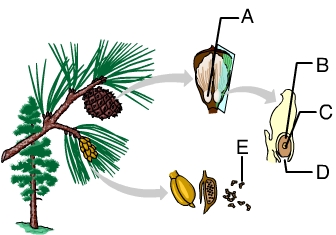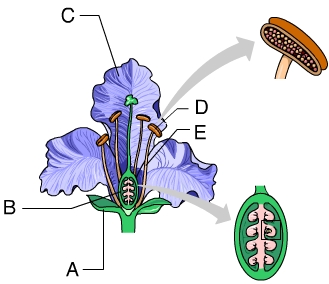 |
| 1 . |
|
Which of these is a male gametophyte? (Activity: Pine Life Cycle) 
|
 |
| 2 . |
|
In pines, the female gametophyte contains _____, each of which contains a(n) _____. (Activity: Pine Life Cycle)
|
 |
| 3 . |
|
In pines, an embryo is a(n) _____. (Activity: Pine Life Cycle)
|
 |
| 4 . |
|
In pine trees, pollen grains get to the ovule via the _____. (Activity: Pine Life Cycle)
|
 |
| 5 . |
|
Which of these statements is true about the gametophyte tissue that surrounds the pine embryo? (Activity: Pine Life Cycle)
|
 |
| 6 . |
|
Of the four haploid cells produced by a pine cone's megasporocyte (megaspore mother cell), _____ survive(s). (Activity: Pine Life Cycle)
|
 |
| 7 . |
|
In the pine, microsporangia form _____ microspores by _____. (Activity: Pine Life Cycle)
|
 |
| 8 . |
|
Ovules are found within structure _____. (Activity: Angiosperm Life Cycle) 
|
 |
| 9 . |
|
Which of these is unique to flowering plants? (Activity: Angiosperm Life Cycle)
|
 |
| 10 . |
|
The male gametophytes of flowering plants are also referred to as _____. (Activity: Angiosperm Life Cycle)
|
 |
| 11 . |
|
In flowering plants the integuments of the ovule develop into a(n) _____. (Activity: Angiosperm Life Cycle)
|
 |
| 12 . |
|
A carpel is composed of _____. (Activity: Angiosperm Life Cycle)
| | ovary, ovule, and anther |
| | ovule, megasporocyte, and anther |
| | zygote, anther, and endosperm |
| | stigma, style, and ovary |
| | petal, sepal, and stamen |
|
 |
| 13 . |
|
In flowering plants one megaspore gives rise to _____ nuclei. (Activity: Angiosperm Life Cycle)
|
 |
| 14 . |
|
A stamen consists of _____. (Activity: Angiosperm Life Cycle)
|
 |
| 15 . |
|
In angiosperms, pollination is the transfer of pollen grain to the _____ of a flower on the same plant or another plant of the same species. (Activity: Angiosperm Life Cycle)
|
 |
|